Please be aware of our copyright notice. If you have a good reaon for using a photo from this site ask permission from first - it is frequently given.
Southern Signals
Semaphore Signals
| Some single post signals. |
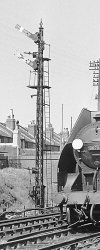 |
Left: A good "off"! Stop and caution arms raised to the
heavens as 30789 Sir Guy passes
in the opposite direction at Fratton.
photograph: Mike Morant collection Right: The platform starter adjacent to the Signalbox at Baynards. This signal was fairly short so that the driver would have good sighting of it when awaiting departure from the station. Baynards was on the Horsham to Guildford secondary line and, with mainly stopping traffic, there was no need for a taller post. Note the construction of the signal, which is typical of a Southern Railway built one. The post is old running rail given a new lease of life and the arm a SR metal upper quadrant. This arm is corrugated whereas the majority of SR arms had a flat face. photograph by Keith Harwood |
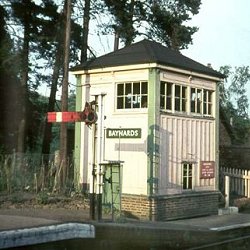 |
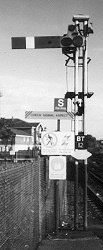 |
Left: The up starting signal at Billingshurst, with a plethora of
information! BT12 is the signal's number and corresponds to the number of
the lever in the Signalbox. The white diamond on the post tells the driver that
the signal is exempt from Rule 55 (regarding trains
standing on a running line) as track circuiting (or an electrical depression
bar) is provided.
photograph by Glen Woods Right: Starting signal at Petersfield. This is on a tall post so that it can be easily sighted by the driver of a non-stopping train and is of LSWR lattice construction. All the pre-grouping companies used lattice posts, which were of similar construction, though there were also a lot of wooden ones. The signal arm is a standard SR arm. photograph by Keith Harwood |
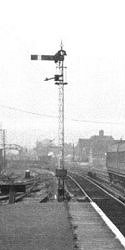 |
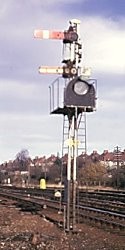 |
Left: Multi-function signal at Tattenham Corner, with a shunt arm
beneath. The big box houses a route indicator which, when the signal is
"off", will tell a driver which route has been set.
photographs used by kind permission of Gregory Duncan-Studart Right: Two arm signal at Carshalton Beeches. The lower, distant, arm advises a driver that the next home (or series of home) signal is "off". The exact meaning is determined by any local instructions that may apply to the Signalbox. |
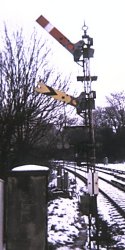 |
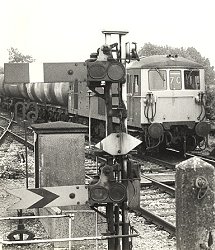 |
A very short signal at Selsdon! Notice that the post is so low that the Rule
55 exempt diamond had to be placed between the two arms.
photograph by the late Eric Arnold, courtesy of the Dick Morant collection |
| Another form of semaphore signal is the illuminated banner repeater signal which is usually placed before a "normal" signal due to a sighting difficulty.This one was photographed at Nursery Road 25 Jan 1974. | 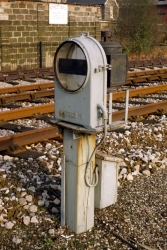 |
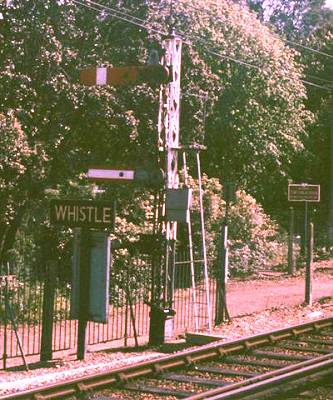 |
A starting signal mounted on a lattice post with a slightly
smaller second arm underneath the main arm. This could be either a
"Warning", a "Shunt Ahead" or a "Calling On" arm,
depending on requirements, with the box on the right of the signal post
displaying either the letter 'W' 'S' or 'C' as
appropriate when the lower arm is off.
Photographed at Sandown, IoW, May 1977. photograph by Clive Standen |
| The warning signal was used to inform a Driver that the
line ahead was only clear until the next home signal. When raised under the
signal controlling the entrance to the section ahead (which, of course, cannot
be raised) the Driver would know that the section was clear but that the
station or junction ahead was blocked. This warning signal would not be pulled
off until the train had been brought to, or nearly to, a stand at the
signal. The shunt ahead signal was used to authorise a Driver to pass the main signal at Danger for shunting purposes only. His train could not proceed on its journey until the signal controlling the entrance to the section had been pulled off. The calling on signal allows a driver to make a movement into an occupied stretch of line. |
| Another, similar, signal also photographed on the Isle of
Wight, though this has a more modern rail-built post. This photograph was taken
at Shanklin on 30 may 1966.
photograph by Ray Soper |
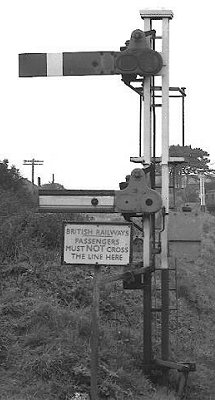 |
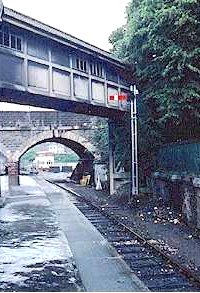 |
Left: The bay starting signal at Exeter Central which was
where the Exmouth trains would start from. Nowadays they begin their journey at
Exeter St Davids! Or run through from Barnstaple.
Right: A gallows signal at Exeter Central. This was an alternative to the bracket signal more normally used. photographs by Paul Martin |
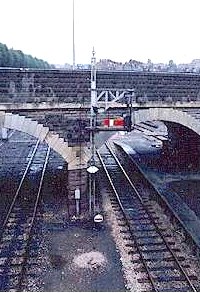 |
| Sometimes a bracket would be used in a situation like this,
but here at Tunbridge Wells West two starting signals, with accompanying shunt
dummies, stood alongside each other at the end of their respective platforms,
photographed during August 1975. They are classic Southern Railway rail-built
posts with Upper Quadrant arms and Westinghouse dummies at their base. There is
another Westinghouse dummy on the right of the photograph, partly in the shadow
of a 'Thumper' that is just arriving. Under the bridge can be seen
another single post signal, this time with a main arm and a subsidiary arm.
photograph by Clive Standen |
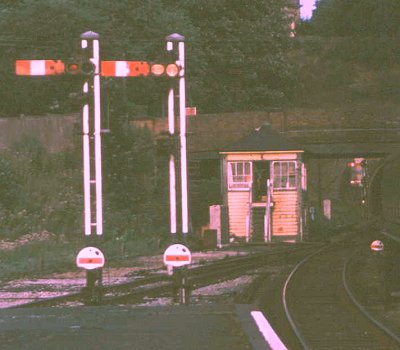 |
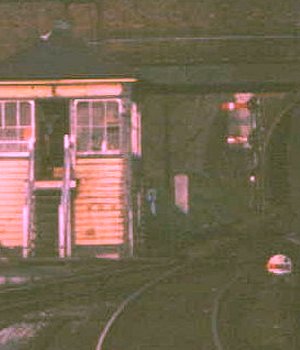 |
A closer view of the signal referred to above shows the
subsidiary arm carries the letter 'S'. This identifies it as a
"Shunt Ahead" signal where the identification is on the arm itself,
as opposed to an indicator alongside a plain arm.
photograph by Clive Standen |
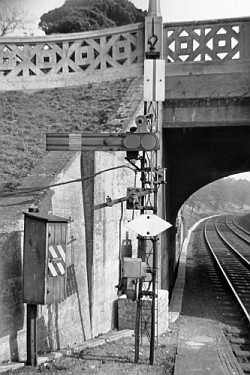 |
The Up Starting Signal at Parkstone showing the front view and,
on the right, the finial and rear view with 34046 Braunton in the
platform.
The plate on the post above the arm informs drivers that Intermediate Block
Section Rules apply on the route ahead. IBS was quite common at one time on the
former L&SWR routes where there were long stretches between boxes and
a relatively high line speed, though very rare on the former LB&SCR and
SE&CR routes with their shorter distances between boxes. photograph by Michael Blackbourn |
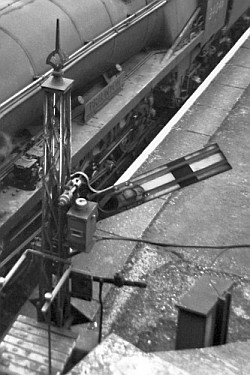 |
Index to pages
This page was last updated 2 January 2011